
Aerial view of the Eiffel Tower with the river Seine, Paris, France, Europe
Discover top 10 historical sites ofFrance, offering a glimpse into its rich cultural heritage and legacy.
A list of some of the top historical places in France that are popular among tourists:
1. Eiffel Tower in Paris
2. Palace of Versailles near Paris
3. Mont Saint-Michel in Normandy
4. Notre-Dame Cathedral in Paris
5. Château de Chambord in the Loire Valley
6. Pont du Gard in Provence
7. Carcassonne in Occitanie
8. Palace of the Popes in Avignon
9. Bayeux Tapestry in Normandy
10. Lascaux Caves in Dordogne
1. Eiffel Tower in Paris:
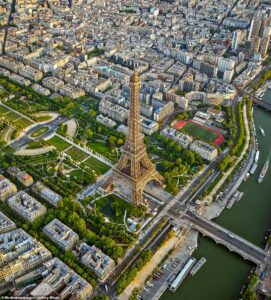
The Eiffel Tower, located in Paris, France, is one of the most iconic landmarks and historical sites in the world and a must-visit destination for tourists.
Here are some details about the Eiffel Tower for tourists:
1. History:
The Eiffel Tower was designed by Gustave Eiffel and built for the 1889 World’s Fair in Paris.
It was initially met with criticism but has since become a symbol of France and a popular tourist attraction.
2. Height:
Standing 1,063 feet tall, the Eiffel Tower was the tallest man-made structure in the world until 1930.
It consists of three levels that visitors can access via stairs or elevators.
3. Views:
The Eiffel Tower offers breathtaking panoramic views of Paris from its observation decks.
Visitors can see famous landmarks such as the Louvre, Notre-Dame Cathedral, and the Arc de Triomphe from the top.
4. Restaurants:
The Eiffel Tower is home to two restaurants, Le 58 Tour Eiffel and Le Jules Verne, offering fine dining experiences with stunning views of the city.
5. Light show:
Every evening, the Eiffel Tower is illuminated with sparkling lights that twinkle for a few minutes, creating a magical sight that attracts visitors and locals alike.
6. Souvenirs:
Visitors can purchase souvenirs and gifts at the Eiffel Tower gift shops located on the ground level, offering a range of merchandise to commemorate their visit.
Overall, the Eiffel Tower is a must-see attraction in Paris, offering a unique experience and stunning views of the city that will leave a lasting impression on tourists.
2. Palace of Versailles near Paris:
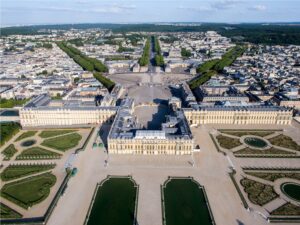
The Palace of Versailles, located near Paris, France, is one of the magnificent historical sites that attracts tourists from around the world.
Here are some details about the Palace of Versailles for tourists:
1. History:
The Palace of Versailles was originally a hunting lodge built by King Louis XIII in the early 17th century.
It was later expanded and transformed into a grand palace by King Louis XIV, known as the Sun King.
2. Architecture:
The Palace of Versailles is renowned for its opulent Baroque architecture, elaborate gardens, and stunning Hall of Mirrors.
The palace features ornate decorations, gilded sculptures, and intricate frescoes that showcase the wealth and power of the French monarchy.
3. Gardens:
The Palace of Versailles is surrounded by expansive formal gardens designed by landscape architect André Le Nôtre.
The gardens feature fountains, sculptures, manicured lawns, and flower beds, providing a picturesque backdrop for visitors to explore.
4. Hall of Mirrors:
The Hall of Mirrors in the palace is a stunning gallery with 17 mirrored arches and crystal chandeliers. It was used for royal ceremonies, receptions, and celebrations.
5. Trianon Palaces:
Within the grounds of the Palace of Versailles, visitors can also explore the Grand Trianon and the Petit Trianon, two smaller palaces that served as private retreats for the royal family.
6. Fountain Shows:
During summer, the Palace of Versailles hosts fountain shows in gardens with music, water displays, and light effects for a magical experience.
All in all, the Palace of Versailles is one of the UNESCO World Heritage Sites and historical sites that offer a glimpse of the royal history of France and grandeur, attracting tourists looking to immerse themselves in the country’s rich cultural heritage, making an essential place for
3. Mont Saint-Michel in Normandy:
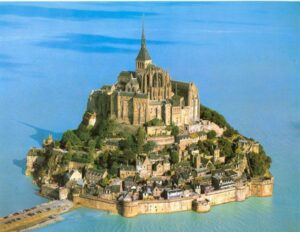
Mont Saint-Michel, located in Normandy, France, is one of the historical sites and picturesque island commune that is a popular destination for tourists.
Here are some details about Mont Saint-Michel for tourists:
1. History:
Mont Saint-Michel has a rich history dating back to the 8th century when a small church was built on the island. Over the centuries, it grew into a fortified abbey and monastery, becoming a major pilgrimage site.
2. Architecture:
The iconic abbey of Mont Saint-Michel is a stunning example of medieval architecture, perched atop a rocky island surrounded by tidal waters.
The abbey features Gothic and Romanesque elements and offers breathtaking views of the surrounding landscape.
3. Tides:
One of the unique features of Mont Saint-Michel is its location in a bay with some of the highest tides in Europe.
The surrounding waters can rise and fall dramatically, creating a dynamic and ever-changing landscape around the island.
4. Abbey tours:
Visitors to Mont Saint-Michel can explore the abbey and its various rooms, chapels, and cloisters on guided tours. The abbey’s architecture and history provide insight into the religious and cultural significance of the site.
5. Village:
The village at the base of Mont Saint-Michel is a charming medieval town with narrow streets, shops, and restaurants.
Visitors can wander through the cobblestone streets and enjoy the picturesque surroundings.
6. Views:
The panoramic views from Mont Saint-Michel are truly spectacular, offering vistas of the surrounding bay, coastline, and countryside.
The island’s elevated position provides a unique perspective on the natural beauty of Normandy.
Overall, Mont Saint-Michel is a must-visit destination for tourists in France, offering a blend of historical sites, architecture, natural beauty, and cultural significance that make it a truly unforgettable experience.
4. Notre-Dame Cathedral in Paris:
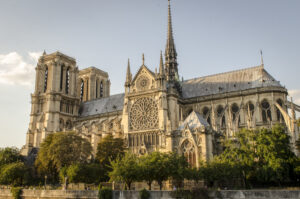
The Notre Dame Cathedral, located in the heart of Paris, France, is a historic and iconic landmark that attracts tourists from around the world.
Here are some details about the Notre-Dame Cathedral for tourists:
1. History:
The Notre Dame Cathedral, also known as Notre-Dame de Paris, was built in the 12th century and is considered a masterpiece of French Gothic architecture.
It has played a significant role in French history and culture.
2. Architecture: The cathedral features stunning architectural details, including its intricate facade, flying buttresses, and iconic rose windows.
Visitors can admire the intricate sculptures and carvings that adorn the exterior and interior of the building.
3. Bell Towers:
The Notre Dame Cathedral is home to two bell towers that visitors can climb to enjoy panoramic views of Paris.
The South Tower houses the famous Emmanuel bell, which has been ringing for centuries.
4. Interior:
The interior of the cathedral is equally impressive, with its high vaulted ceilings, stained glass windows, and ornate decorations.
Visitors can explore the nave, choir, and transepts, as well as the crypt beneath the cathedral.
5. Restoration:
The Notre Dame Cathedral suffered a devastating fire in April 2019, which caused significant damage to the building.
Restoration efforts are currently underway to restore the cathedral to its former glory.
6. Religious significance:
The Notre Dame Cathedral is an active place of worship and holds religious services, concerts, and events throughout the year.
Visitors can attend Mass or simply admire the beauty of the cathedral’s spiritual atmosphere.
Overall, the Notre Dame Cathedral is a must-visit destination for tourists in Paris, offering a glimpse into France’s rich history, culture, and architectural heritage.
5. Château de Chambord in the Loire Valley:
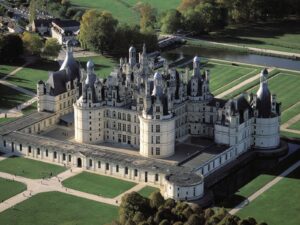
Château de Chambord, located in the Loire Valley of France, is a magnificent Renaissance castle that is a popular destination for tourists.
Here are some details about Château de Chambord for tourists:
1. History:
Château de Chambord was built in the early 16th century as a hunting lodge for King Francis I of France.
It is known for its distinctive French Renaissance architecture and is one of the largest châteaux in the Loire Valley.
2. Architecture:
The château features a unique double-helix staircase attributed to Leonardo da Vinci, who was a guest of King Francis I.
The architectural design of Château de Chambord is a blend of French medieval and Italian Renaissance styles.
3. Gardens:
Surrounding the château are vast and picturesque gardens that offer visitors a peaceful retreat to explore and admire the beauty of the landscape.
The gardens are meticulously maintained and provide a serene setting for a leisurely stroll.
4. Interior:
The interior of Château de Chambord is lavishly decorated with ornate furnishings, tapestries, and artwork that reflect the grandeur of the French Renaissance period.
Visitors can tour the various rooms and chambers to get a glimpse of the castle’s opulent past.
5. Wildlife:
Château de Chambord is also home to a diverse range of wildlife, including deer, boars, and other animals that roam freely on the estate.
Visitors can enjoy observing these animals in their natural habitat while exploring the grounds.
Overall, Château de Chambord is one of the fascinating historical sites that offers tourists a glimpse into the rich history and architectural beauty of the Loire Valley.
Tourists can immerse themselves in the grandeur of this Renaissance castle and enjoy a memorable experience exploring its grounds and interior.
6. Pont du Gard in Provence:
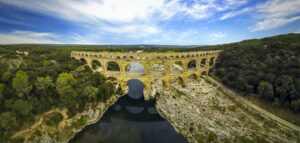
The Pont du Gard is one of the historical Roman sites aqueduct bridge located in Provence, France, and is popular for tourists.
Here are some details about the Pont du Gard for tourists:
1. History:
The Romans constructed the Pont du Gard as a part of a water supply system in the city of Nîmes in the 1st century AD.
One of the world’s best-preserved Roman aqueducts is regarded as one of its best-preserved aqueducts.
2. Architecture:
The Pont du Gard is a three-tiered bridge made of limestone blocks without the use of mortar.
It spans the Gardon River and stands at a height of 160 feet, showcasing the engineering prowess of the ancient Romans.
3. Scenic beauty:
The Pont du Gard is set in a picturesque natural landscape, surrounded by lush greenery and the flowing waters of the Gardon River.
Visitors can enjoy leisurely walks along the riverbanks and admire the stunning views of the aqueduct.
4. Visitor center:
The Pont du Gard site includes a visitor center with exhibits and information about the history and construction of the aqueduct.
Guided tours are available for those interested in learning more about the site.
5. Activities:
In addition to exploring the Pont du Gard itself, visitors can engage in various activities such as picnicking, hiking, and swimming in the river.
There are also restaurants and cafes nearby for a relaxing break.
6. UNESCO World Heritage Site:
The Pont du Gard is a designated UNESCO World Heritage Site, recognizing its cultural significance and historical importance as a masterpiece of Roman engineering.
Overall, the Pont du Gard is one of the fascinating historical sites in France that offers a blend of architectural marvels, natural beauty, and recreational opportunities for tourists to enjoy.
7. Carcassonne in Occitanie:
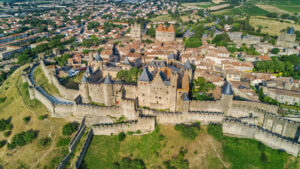
Carcassonne, located in the Occitanie region of France, is a medieval fortified city that is a popular destination for tourists.
Here are some details about Carcassonne for tourists:
1. History:
Carcassonne is renowned for its 52 towers and well-preserved medieval architecture.
The city has a rich history dating back to Roman times and played a significant role in the Cathar Crusades.
2. La Cité:
The main attraction in Carcassonne is La Cité, the medieval citadel that is a UNESCO World Heritage Site.
Visitors can explore the narrow cobblestone streets, visit the Château Comtal (Count’s Castle), and walk along the ramparts for panoramic views of the surrounding countryside.
3. Basilica of Saint-Nazaire:
Within La Cité, tourists can visit the Basilica of Saint-Nazaire, a stunning example of Gothic architecture with beautiful stained glass windows and intricate carvings.
4. Canal du Midi:
Carcassonne is also located near the Canal du Midi, a UNESCO-listed canal that connects the Mediterranean Sea to the Atlantic Ocean.
Tourists can take boat trips along the canal and enjoy the picturesque scenery.
5. Festivals and events:
Throughout the year, Carcassonne hosts various festivals and events, including the Festival de Carcassonne in the summer, featuring music, theater, and dance performances.
6. Local cuisine:
Visitors to Carcassonne can enjoy traditional Occitan cuisine at local restaurants, including dishes such as cassoulet (a hearty bean stew with meat) and regional wines from the Languedoc-Roussillon vineyards.
Overall, Carcassonne offers a unique blend of history, architecture, and culture that makes it a must-visit destination for tourists exploring the Occitanie region of France.
8. Palace of the Popes in Avignon:
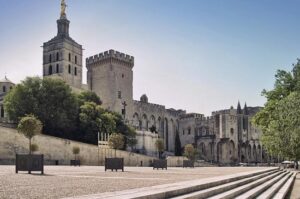
The Palace of the Popes, located in Avignon, France, is a historic and architectural marvel that attracts tourists from around the world. Here are some details about the Palace of the Popes for tourists:
1. History:
The Palace of the Popes served as the residence of the popes in the 14th century when the papacy moved from Rome to Avignon.
It is one of the largest and most important medieval Gothic buildings in Europe.
2. Architecture:
The palace is a stunning example of Gothic architecture, with its massive stone walls, towers, and intricate detailing.
Visitors can explore the various rooms, chapels, and courtyards that showcase the grandeur of the papal residence.
3. Art and Decor:
The Palace of the Popes houses a collection of medieval frescoes, tapestries, and sculptures that provide insight into the artistic and cultural heritage of the time.
The ornate decorations and furnishings reflect the wealth and power of the papal court.
4. Avignon Bridge:
The Palace of the Popes is located near the famous Pont d’Avignon (Avignon Bridge), a UNESCO World Heritage Site that offers picturesque views of the Rhône River and the surrounding landscape.
5. Events and Exhibitions:
The Palace of the Popes hosts various events, exhibitions, and cultural activities throughout the year, allowing visitors to immerse themselves in the history and heritage of the region.
Overall, the Palace of the Popes in Avignon is a must-visit destination for tourists interested in history, architecture, and art, offering a glimpse into the medieval papal era and the rich cultural legacy of Avignon.
9. Bayeux Tapestry in Normandy:
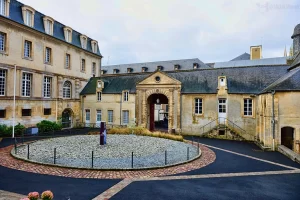
The Bayeux Tapestry, located in Normandy, France, is one of the remarkable historical sites that attracts tourists from around the world.
Here are some details about the Bayeux Tapestry for tourists:
1. History:
The Bayeux Tapestry is an embroidered cloth nearly 70 meters long that depicts the events leading up to the Norman conquest of England by William the Conqueror in 1066.
It is believed to have been created shortly after the Battle of Hastings.
2. Display:
The Bayeux Tapestry is displayed in the Museum of the Bayeux Tapestry in the town of Bayeux, where visitors can view the entire tapestry in a specially designed exhibition space.
3. Artistry:
The Bayeux Tapestry is a masterpiece of medieval art, featuring intricate embroidery and detailed scenes that tell the story of the Norman conquest in a narrative format.
4. Interpretation:
Audio guides and informational panels at the museum provide visitors with insights into the historical context and significance of the Bayeux Tapestry, offering a deeper understanding of its importance.
5. Conservation:
The Bayeux Tapestry has undergone extensive conservation efforts to preserve its delicate fabric and intricate embroidery, ensuring that future generations can continue to appreciate this unique historical artifact.
Visiting the Bayeux Tapestry in Normandy offers tourists a fascinating glimpse into medieval history and artistry, making it a must-see destination for those interested in the events of the Norman conquest and the art of embroidery.
10. Lascaux Caves in Dordogne:
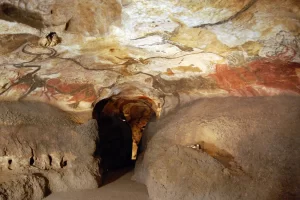
The Lascaux Caves, located in Dordogne, France, are a renowned archaeological site and a UNESCO World Heritage Site that attract tourists from around the world.
Here are some details about the Lascaux Caves for tourists:
1. Discovery:
The Lascaux Caves were discovered in 1940 by four teenagers and are famous for their Paleolithic cave paintings, which date back over 17,000 years.
2. Paintings:
The caves are known for their intricate and well-preserved prehistoric paintings of animals, humans, and abstract symbols.
The artwork provides valuable insights into the lives and beliefs of early humans.
3. Replica:
Due to concerns about preserving the original cave paintings, a replica of the Lascaux Caves, known as Lascaux II, was created and opened to the public in 1983.
This replica allows visitors to experience the beauty of the cave art without damaging the original site.
4. Visitor Center:
The Lascaux Caves Visitor Center provides information about the history and significance of the cave paintings, as well as interactive exhibits and displays that enhance the visitor experience.
5. Guided Tours:
Visitors can explore the Lascaux Caves on guided tours led by knowledgeable guides who provide insights into the art, history, and significance of the site.
6. Surrounding Area:
Dordogne is known for its picturesque landscapes, charming villages, and rich culinary traditions, making it an ideal destination for tourists interested in history, culture, and natural beauty.
Overall, the Lascaux Caves offer a unique and fascinating glimpse into prehistoric art and culture, making them a must-visit destination for tourists exploring the Dordogne region of France.







